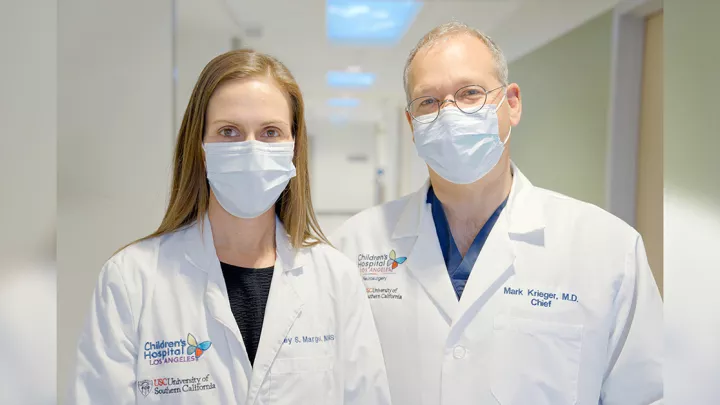
Embedding Endocrine Care for Children With Brain Tumors

Children with brain tumors are at high risk for developing endocrine issues—including growth hormone deficiency, pubertal abnormalities, adrenal problems, bone changes and weight challenges. Unfortunately, though, these issues are not always diagnosed soon enough.
“Sometimes, by the time a child is referred to endocrinology, it’s too late to intervene,” says Clement Cheung, MD, PhD, Director of the Neuroendocrine Program at Children’s Hospital Los Angeles. “A boy might be 14 years old and shorter than expected, but he has already completed puberty. At that point, his bones have fused, so there is no longer an opportunity to positively impact his growth.”
That’s why, when Dr. Cheung arrived at Children’s Hospital Los Angeles in 2013, he proposed creating a special “embedded” arrangement with the hospital’s Neuro-Oncology Program. Under this model, he sees patients right in the Neuro-Oncology Clinic—consulting on care for brain tumor patients, soon after their cancer diagnosis.
“The beauty of that is, instead of being segregated in a separate clinic where I’m only looking at endocrine issues, I get to look at the whole patient from all different angles,” he says. “I can really learn about the patient’s cancer treatment, watch their development, and be the eyes and ears to look out for these endocrine conditions.”
The results? Preliminary data from the team’s recent study of children with medulloblastoma who were treated with radiation therapy found that those seen in the embedded clinic were diagnosed with growth hormone deficiency nearly two years earlier than patients referred to Endocrinology under traditional care models.

On the same wavelength
As part of the embedded model, Dr. Cheung participates in the neuro-oncology team’s weekly tumor board—hearing firsthand from the neurosurgeon, neurologist, neuro-oncologist and other specialists involved in each child’s care.
He also meets weekly with his colleagues in neuro-oncology to discuss every patient they will see in the upcoming clinic.
“That allows all of us to be thinking on the same wavelength,” he notes. “Patients who are still undergoing cancer treatment may already be showing signs of endocrine problems. This way, I can see them right away. There’s no delay.”
Ashley Margol, MD, MS, Director of the Neuro-Oncology Program, says the embedded arrangement significantly improves patient care.
“We are diagnosing patients with endocrinopathies earlier than we were in a traditional referral model and in a much more coordinated fashion,” Dr. Margol says. “We’re also able to have real-time conversations with Dr. Cheung about the timing and appropriateness of starting certain medications, allowing us to deliver the highest level of care to these complex patients.”
In addition, the team works closely with other specialists and endocrinologists at Children’s Hospital Los Angeles, including Priyanka Bakhtiani, MD, who leads a clinic for childhood cancer survivors with endocrine issues. That clinic is focused on survivors of leukemias and bone and soft tissue tumors.
Streamlining care
Better care coordination also helps ensure that patients receive timely lab tests to monitor levels of reproductive, thyroid, growth factor and stress hormones.
The team’s weekly meetings allow Dr. Cheung to identify patients who need endocrine-related blood tests. The team then arranges for those tests to be done at the same time as the child’s regular brain MRI—ensuring the results are ready at the time of the clinic visit.
“It’s made a tremendous difference in managing these patients,” he says. “And while it may sound minor, the child doesn’t need to get poked a second time. They’re already getting an IV placed for the MRI, so the blood is drawn at the same time.”
Streamlining care also means families aren’t overburdened with too many appointments on different dates and in different locations.
“In our experience, it has made it easier for families to make it to their appointments and discuss any issues around medications. This in turn has led to improved patient satisfaction and more patients being able to take their medications,” Dr. Margol says. “And for us as neuro-oncologists, we have become much more aware of the risk of endocrine issues in our patients. This model ensures that each patient is screened regularly and gets timely diagnosis and treatment.”
Even the physical setup of the clinic itself—which is under the Cancer and Blood Disease Institute—fosters team care. Physicians, nurse practitioners, nurses, social workers and support staff all work side by side in the same space.
“It’s very collaborative instead of hierarchical,” Dr. Cheung says. “In a way, it’s symbolic of what this clinic is about. We’re all working together to provide the best care for patients.”


